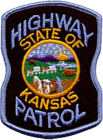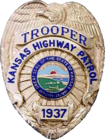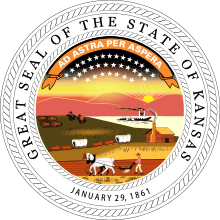Kansas Highway Patrol
| Kansas Highway Patrol | |
|---|---|
| Abbreviation | KHP |
|
Patch of the Kansas Highway Patrol | |
|
Logo of the Kansas Highway Patrol | |
|
Badge of the Kansas Highway Patrol | |
| Motto | Service · Courtesy · Protection |
| Agency overview | |
| Formed | 1937 |
| Preceding agency | Kansas Motor Vehicle Inspectors |
| Employees | 840 (as of 2004) [1] |
| Legal personality | Governmental: Government agency |
| Jurisdictional structure | |
| Operations jurisdiction* | State of Kansas, US |
 | |
| Kansas Highway Patrol Troop Map | |
| Size | 82,277 square miles (213,100 km2) |
| Population | 2,775,997 (2007 est.)[2] |
| General nature |
|
| Operational structure | |
| Headquarters | Topeka, Kansas |
| Troopers | 541 (as of 2004) [1] |
| Civilians | 299 (as of 2004) [1] |
| Agency executive | Colonel Mark Bruce, Superintendent |
| Child agency | Kansas Capitol Police |
| Facilities | |
| Troops | 15 |
| Website | |
|
www | |
| Footnotes | |
| * Divisional agency: Division of the country, over which the agency has usual operational jurisdiction. | |
The Kansas Highway Patrol is a law-enforcement agency that serves the state of Kansas. While the Patrol's primary focus is maintaining the safety of State, Federal and Interstate highways, it also is charged with providing support for rural and small municipal police departments when tactical, aerial or other specialized services are needed. The Kansas Highway Patrol has statewide jurisdiction, and frequently assists other agencies with emergency calls for service ranging from accidents to fights in progress.
History
In 1933, the Kansas Legislature, Governor Alfred Landon, and Highway Department Attorney Wint Smith acted to halt the rampant bank robberies and crime sprees of the 1920s and 1930s. They created a force of ten motor vehicle inspectors, forerunners of Kansas troopers.[3]
The Legislature officially organized the Kansas Highway Patrol in 1937. A superintendent, assistant superintendent, and 45 troopers were hired to reduce crashes by enforcing traffic, vehicle, and license laws. Kansas City Police Department veteran Jack B. Jenkins was the first superintendent.[3]
The governor appointed the superintendent, and the superintendent appointed the rest. All appointees had to pass a physical exam and be U.S. citizens, at least 24 years old, of good health and moral character, and without a criminal record. The 1941 Kansas Civil Service Law affected appointment procedures, but as late as 1945, half the appointees had to belong to the governor's political party, and the other half had to come from the party that placed second in the gubernatorial race.[3]
In the 1950s, the Patrol began to police the turnpike for the Kansas Turnpike Authority, and Protective Services began with one trooper providing the governor's ground transportation. The recruit school moved from the Kansas State Reformatory in Hutchinson to the University of Kansas in Lawrence. Increasingly, troopers patrolled alone. Before, they always rode in pairs.[3]
In the 1960s, each trooper was assigned a patrol car to improve roadway coverage, and access to the Law Enforcement Teletype System and National Crime Information Center improved the Patrol's communications. The first promotional examinations were given, and the deactivated Schilling Air Force Base in Salina became the Patrol's Training Center. Also, the Motor Vehicle Department began examining license applicants, releasing trooper-examiners for other duties.[3]
In 1976, the Patrol gained authority over the Capitol Area Security Patrol, which now is the Capitol Police, or Troop K. In 1988, authority over the Motor Carrier Inspectors passed from the Department of Revenue to the Patrol. Then in 1994, the Training Academy, or Troop J, moved to the former Marymount College campus in Salina.[3]
The first female troopers joined the Patrol in 1981. Today, the agency actively recruits women and men to be troopers and to fill other uniformed and civilian positions. Besides troopers, the agency employs capitol police officers and guards, motor carrier inspectors, communications specialists, vehicle identification number inspectors, and civilians in a variety of other support positions.[3]
In the 1990s it moved its training center and statewide dispatch center from the Salina airport to the former campus of Marymount College (Kansas) in Salina, Kansas.[4][5]
Morale controversy
In 2014, amidst many allegations of abuse of power and inconsistent work practices resulting in overall low morale, the University of Kansas School of Business proctored a thorough survey of all KHP Employees that were willing to participate. The results of the survey revealed that the majority held great loyalty to the agency, but believed upper-level command staff needlessly doled out disciplinary actions to those they personally disliked, showed favoritism during promotional processes, and were generally incompetent when it came to making important decisions regarding the overall direction of the Patrol. Colonel Ernest Garcia and Lieutenant Colonel Alan Stoecklein were both mentioned by name multiple times in an open-ended section at the end of the survey where employees could comment freely. Kansas State Troopers Association President Mitch Mellick said that the survey revealed concerns that had long been held by troopers across the state regarding labor practices and benefits. Lieutenant Colonel Stoecklein soon thereafter announced his retirement, effective September 15th, 2014 and Colonel Ernest Garcia announced he was leaving the agency on January 5th, 2015. [6] [7][8]
Organization
The Patrol is under the direction of the Highway Patrol Superintendent, who holds the rank of Colonel within the Patrol. The Superintendent is appointed by the Governor of Kansas. The Superintendent is aided by an Assistant Superintendent, who is appointed by the Superintendent. The Assistant Superintendent holds the rank of Lieutenant Colonel and serves as second in command of the Patrol. Under the Assistant Superintendent are four Majors who serve as Division Commanders. Together these six officers comprise the command staff of the Patrol.
The Patrol is made up of several geographical headquarters units, referred to as "Troops".[9]
- East Region Command
- Troop A (Kansas City Metro)
- Troop B (Topeka)
- Troop G (Kansas Turnpike)
- Troop H (Chanute)
- Troop I (Motor Carrier Safety)
- Emergency Operations / Homeland Security
- West Region Command
- Troop C (Salina)
- Troop D (Hays)
- Troop E (Garden City)
- Troop F (Wichita)
- Troop S (Special Response Team, Bomb Squad, K9 Unit)
- Support Services Division
- Troop J (Training Academy)
- Public and Governmental Affairs
- Fleet Services
- Auto Theft / VIN Inspection
- Human Resources
- Records
- Information Technology
- Special Services Division
- Troop K (Capitol Police)
- Troop L (Protective Services)
- Troop M (Central Communications)
- Troop N (Domestic Highway Enforcement Team)
- Troop T (Aircraft Operations)
- Professional Standards Unit
Rank structure
| Title | Insignia | Description |
|---|---|---|
| Superintendent | |
Rank of Colonel, appointed by the Governor of Kansas to be the professional head of the Department |
| Assistant Superintendent | |
Rank of Lieutenant Colonel, second-in-command of Patrol, appointed by the Superintendent |
| Major | |
Regional and Division Commanders |
| Captain | |
Troop Commander |
| Lieutenant | |
First Line Supervisor- Highway Patrol / Second Line Supervisor- Capitol Police |
| Sergeant | 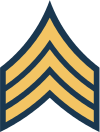 |
First supervisory rank for Capitol Police and Motor Carrier Inspectors only. |
| Technical Trooper | |
Rank held by veteran Troopers assigned to a technical specialty (e.g. Bomb Technicians, Aircraft Pilots, Canine Handlers, Task Force Officers) |
| Master Trooper | |
Rank attained by Trooper after completion of 5 years of service and completion of advanced professional training. |
| Trooper | |
Rank attained by Recruits upon successful completion of the training academy, responsible for field law enforcement patrol. |
| Recruit | |
This rank is held by law enforcement officers while attending the KHP training academy. |
Officers of the Patrol
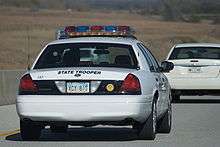
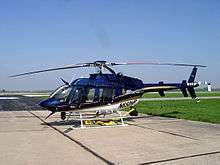
State Troopers
State troopers are certified law enforcement officers who enforce Kansas laws. Troopers have law enforcement jurisdiction throughout the state. Daily responsibilities include performing traffic stops, providing emergency medical assistance, assisting motorists, investigating crashes, detecting and deterring criminal activity, and assisting other law enforcement agencies. State troopers assist during civil disturbances and natural disasters, provide law enforcement at the Kansas State Fair, inspect school buses and motor vehicles, testify in court, and educate the public about traffic safety.[10]
Capitol Police
The Kansas Capitol Police as they are known today are members of a specialty troop of the Kansas Highway Patrol (Troop K). The Capitol Police originally became part of the Kansas Highway Patrol in 1976, under the designation of Kansas Capitol Area Security Patrol or C.A.S.P.
In the early days of C.A.S.P., the police officers of this special unit were statutorily only allowed to enforce laws on or about state property; leaving them powerless to act on a violation of the law when traveling from one property to another.
In 1995 The Kansas Legislature gave county wide law enforcement jurisdiction to the Capitol Police, and several years thereafter full statewide jurisdiction. With this added jurisdiction and the expanding role of C.A.S.P. legislation was also passed to officially change the name of the unit from C.A.S.P. to the Kansas Capitol Police.
Troop K is 1 of only 2 troops that provide 24-hour, 7-day-a-week police coverage. This coverage currently entails answering calls for service/patrolling over 100 state properties in Shawnee County Kansas, assisting other law enforcement agencies, investigation traffic accidents, intervening in crimes in progress, and traffic enforcement. The Capitol Police are also charged with providing uniformed police protection at the governor’s mansion, the statehouse, The Grand Army of the Republic Memorial Museum, the insurance regulation building, and the judicial center.
Every capitol police officer has been equipped with an M-4 rifle, and has received extensive building search/active shooter training.
Troop K is the largest troop of the Kansas Highway Patrol. The Capitol Police are currently staffed by a troop captain, an administrative lieutenant, a patrol lieutenant, 5 sergeants, 26 building police officers, 13 road patrol police officers, a special investigator, 4 dispatchers, 26 non-sworn capitol area guards, a secretary, and an electronic locksmith technician. Patrols are currently accomplished by the use of Ford Crown Victorias, Dodge Chargers, and police officers that have been cross trained to utilize police bicycles.
Motor Carrier Inspectors
Motor Carrier Inspectors perform thousands of roadside inspections each year, and enforce state laws and federal regulations that promote the safe operation of commercial motor vehicles. MCIs enforce state statutes governing size and weight of vehicles, assist stranded motorists, promote voluntary compliance with the law through educational programs, testify in court, and assist during civil disturbances, natural disasters, and crash scenes. MCIs also train outside agencies in commercial motor vehicle weight and safety regulations.
Motor Carrier Inspectors work at established scale houses throughout the state, and MCI Law Enforcement Officers conduct mobile inspections. The MCI Law Enforcement Officers are certified law enforcement officers, who in addition to inspecting commercial motor vehicles, detect and deter criminal activity, and apprehend criminal offenders.[11]
Communications Specialist
Communications Specialists support field personnel 24 hours a day, seven days a week by rapidly and efficiently broadcasting information from the Highway Patrol’s Central Communications Center in Salina, Kan. Daily responsibilities include operating a data entry terminal and radio communication system to send, relay, and receive information. Communications Specialists maintain continuous contact among Highway Patrol personnel and other emergency response agencies, and they disseminate information for officers to apprehend offenders, develop investigative leads, track criminal activity, identify stolen property, and locate missing persons.
Communications Specialists also coordinate emergency medical relays across the state using aircraft and ground units, and monitor alarms and warning systems, such as those issued by the National Weather Service and local emergency managers.[12]
Equipment
Firearms
| Name | Type | Caliber | Origin | Notes |
|---|---|---|---|---|
| Glock 21SF | Pistol | .45 auto | | Standard Issue |
| Glock 30SF | Pistol | .45 auto | | Protective Services & Task Force Troopers |
| Glock 22 Gen4 | Pistol | .40 S&W | | Kansas Turnpike (Troop G) Troopers |
| Mossberg 500 | Shotgun | 12 Gauge | | Kansas Turnpike (Troop G) Troopers |
| Remington 870 | Shotgun | 12 Gauge | | Standard Issue |
| Colt M4 | Patrol Rifle | 5.56mm | | Standard Issue |
| H&K 416 | Tactical Rifle | 5.56mm | | Special Response Team (SRT) |
| H&K MP5SD | Tactical Carbine | 9mm | | Special Response Team (SRT) |
Vehicles
The Kansas State Troopers operate the following vehicles:
- Dodge Charger
- Chevrolet Tahoe
- Ford Expedition
- Ford Taurus Police Interceptior Sedan (sixth generation)
- Ford Crown Victoria Police Interceptor
- Ford Explorer (Police Interceptor Utility)
- Chevrolet Impala 9C1 & 9C3 (Ninth Generation)
Fallen officers
Since the establishment of the Kansas Highway Patrol, 10 officers have died in the line of duty.[13][14]
| Officer | Date of Death | Details |
|---|---|---|
| Trooper Maurice R. Plumber | |
Automobile accident[15] |
| Trooper Jimmie D. Jacobs | |
Automobile accident[16] |
| Trooper John B. McMurray | |
Vehicular assault[17] |
| Lieutenant Bernard C. Hill] | |
Automobile accident[18] |
| Sergeant Eldon K. Miller | |
Gunfire[19] |
| Trooper James Donald Thornton | |
Gunfire[20] |
| Trooper Conroy G. O’Brien | |
Gunfire[21] |
| Trooper Ferdinand Frederick Pribbenow | |
Gunfire[22] |
| Master Trooper Larry Lee Huff | |
Automobile accident[23] |
| Master Trooper Dean Allen Goodheart | |
Struck by vehicle[24] |
See also
References
- 1 2 3 USDOJ Statistics
- ↑ 2007 Population Estimates
- 1 2 3 4 5 6 7 "History of the KHP". kansashighwaypatrol.org.
- ↑ This site is maintained the New Media Department of the Salina Journal. "Salina.com - an online service of The Salina Journal". saljournal.com.
- ↑ Kansas Highway Patrol Training Academy - kansashighwaypatrol.org - Retrieved March 6, 2009
- ↑ "KHP survey points to dissatisfaction with leadership, alleged favoritism". CJOnline.com.
- ↑ "Kansas Highway Patrol superintendent to retire". KSN-TV.
- ↑ "Longtime KHP trooper to retire, says so long at his 28th state fair". The Hutchinson News.
- ↑ Kansas Highway Patrol Troop Locations http://www.kansashighwaypatrol.org/field_op/troops.html
- ↑ "Career Opportunities for Trooper". kansashighwaypatrol.org.
- ↑ KHP Motor Vehicle Inspector page http://www.kansashighwaypatrol.org/careerop/co_mci.html
- ↑ "Career Opportunities for Communications Specialist". kansashighwaypatrol.org.
- ↑ Kansas Highway Patrol Memorial page http://www.kansashighwaypatrol.org/memory/memorial.html
- ↑ Officer Down Memorial Page http://www.odmp.org/agency/1938-kansas-highway-patrol-kansas
- ↑ "Honoring our Fallen - Plummer". Kansashighwaypatrol.org. Retrieved 2015-10-08.
- ↑ "Honoring our Fallen - Jacobs". Kansashighwaypatrol.org. Retrieved 2015-10-08.
- ↑ "Honoring our Fallen - McMurray". Kansashighwaypatrol.org. Retrieved 2015-10-08.
- ↑ "Honoring our Fallen - Hill". Kansashighwaypatrol.org. Retrieved 2015-10-08.
- ↑ "Honoring our Fallen - Miller". Kansashighwaypatrol.org. Retrieved 2015-10-08.
- ↑ "Honoring our Fallen - Thornton". Kansashighwaypatrol.org. Retrieved 2015-10-08.
- ↑ "Honoring our Fallen - O'Brien". Kansashighwaypatrol.org. Retrieved 2015-10-08.
- ↑ "Honoring our Fallen - Pribbenow". Kansashighwaypatrol.org. Retrieved 2015-10-08.
- ↑ "Honoring our Fallen - Huff". Kansashighwaypatrol.org. Retrieved 2015-10-08.
- ↑ "Honoring our Fallen - Goodheart". Kansashighwaypatrol.org. Retrieved 2015-10-08.
